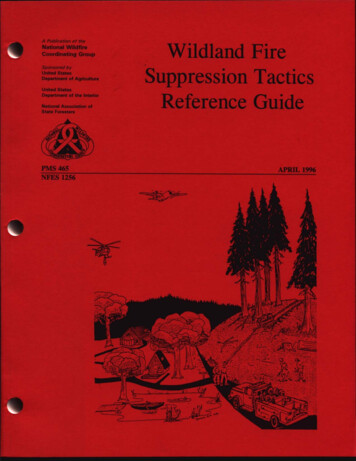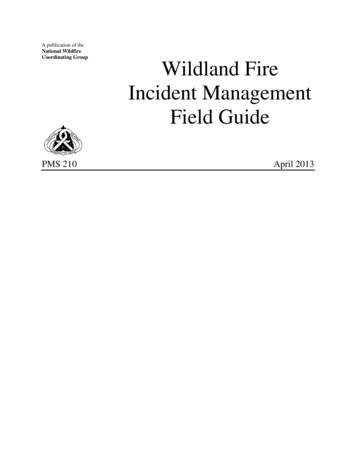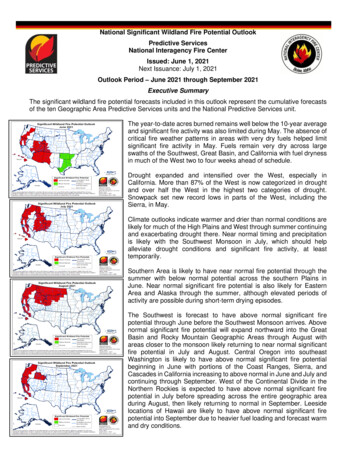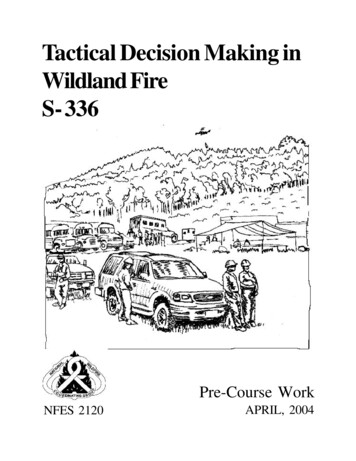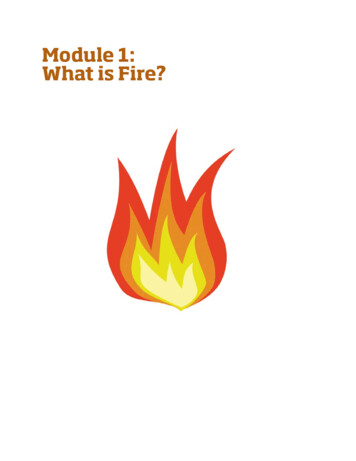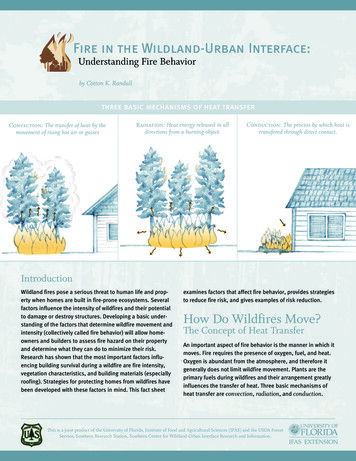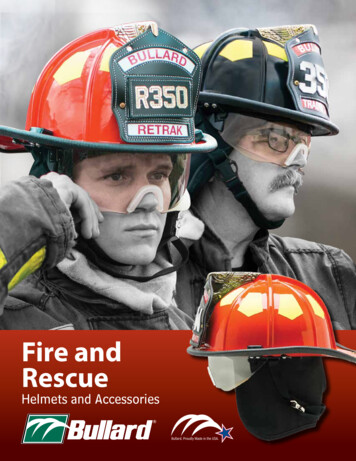
Transcription
United StatesDepartmentof AgricultureForest ServiceRocky MountainResearch StationGeneral TechnicalReport RMRS-GTR-42volume 4September 2005Wildland Fire inEcosystemsEffects of Fire on Soil and Water
AbstractNeary, Daniel G.; Ryan, Kevin C.; DeBano, Leonard F., eds. 2005. (revised 2008). Wildland fire inecosystems: effects of fire on soils and water. Gen. Tech. Rep. RMRS-GTR-42-vol.4. Ogden,UT: U.S. Department of Agriculture, Forest Service, Rocky Mountain Research Station. 250 p.This state-of-knowledge review about the effects of fire on soils and water can assist land and firemanagers with information on the physical, chemical, and biological effects of fire needed to successfullyconduct ecosystem management, and effectively inform others about the role and impacts of wildlandfire. Chapter topics include the soil resource, soil physical properties and fire, soil chemistry effects, soilbiology responses, the hydrologic cycle and water resources, water quality, aquatic biology, fire effectson wetland and riparian systems, fire effects models, and watershed rehabilitation.Keywords: ecosystem, fire effects, fire regime, fire severity, soil, water, watersheds, rehabilitation, soilproperties, hydrology, hydrologic cycle, soil chemistry, soil biology, fire effects modelsThe larger bold check-mark boxes indicate the volumes in “The Rainbow Series” currently published. To order, check any box orboxes below, fill in the address form, and send to the mailing address listed below. Or send your order and your address in mailinglabel form to one of the other listed media.RMRS-GTR-42-vol. 1. Wildland fire in ecosystems: effects of fire on fauna.RMRS-GTR-42-vol. 2. Wildland fire in ecosystems: effects of fire on flora.RMRS-GTR-42-vol. 3. Wildland fire in ecosystems: effects of fire on cultural resources and archeology.RMRS-GTR-42-vol. 4. Wildland fire in ecosystems: effects of fire on soil and water.RMRS-GTR-42-vol. 5. Wildland fire in ecosystems: effects of fire on air.Send to:NameAddressCover photo—Left photo: Wildfire encroaching on a riparian area, Montana, 2002.(Photo courtesy of the Bureau of Land Management, National Interagency FireCenter, Image Portal); Right photo: BAER team member, Norm Ambos, TontoNational Forest, testing for water repellancy, Coon Creek Fire 2002, Sierra AnchaExperimental Forest, Arizona.
Wildland Fire in EcosystemsEffects of Fire on Soil and WaterEditorsDaniel G. Neary, Project Leader, Forestry Sciences Laboratory, Rocky Mountain ResearchStation, U.S. Department of Agriculture, Forest Service, Flagstaff, AZ 86001Kevin C. Ryan, Project Leader, Fire Sciences Laboratory, Rocky Mountain Research Station,U.S. Department of Agriculture, Forest Service, Missoula, MT 59807Leonard F. DeBano, Adjunct Professor, School of Renewable Natural Resources, Universityof Arizona, Tucson, AZ 85721Johanna D. Landsberg, Research Soil Scientist (Retired), Pacific Northwest Research Station, U.S. Department of Agriculture, Forest Service, Wenatchee, WA98801AuthorsJan L. Beyers, Research Ecologist, Pacific SouthwestResearch Station, U.S. Department of Agriculture, Forest Service, Riverside, CA 92507Daniel G. Neary, Project Leader, Rocky Mountain Research Station, U.S. Department of Agriculture, ForestService, Flagstaff, AZ 86001James K. Brown, Research Forester, Systems for Environmental Management, Missoula, MT 59802 (formerlywith Fire Sciences Laboratory, Rocky Mountain Research Station, U.S. Department of Agriculture, ForestService).James R. Reardon, Physical Science Technician, RockyMountain Research Station, U.S. Department of Agriculture, Forest Service, Missoula, MT59807Matt D. Busse, Research Microbiologist, Pacific Southwest Research Station, U.S. Department of Agriculture,Forest Service, Redding, CA 96001John N. Rinne, Research Fisheries Biologist, RockyMountain Research Station, U.S. Department of Agriculture, Forest Service, Flagstaff, AZ 86001Leonard F. DeBano, Adjunct Professor, School of Renewable Natural Resources, University of Arizona, Tucson, AZ 85721Peter R. Robichaud, Research Engineer, Rocky Mountain Research Station, U.S. Department of Agriculture,Forest Service, Moscow, ID 83843William J. Elliot, Project Leader, Rocky Mountain Research Station, U.S. Department of Agriculture, ForestService, Moscow, ID 83843Kevin C. Ryan, Project Leader, Rocky Mountain Research Station, U.S. Department of Agriculture, ForestService, Missoula, MT59807Peter F. Ffolliott, Professor, School of Renewable Natural Resources, University of Arizona, Tucson, AZ 85721Gerald R. Jacoby, Professor Emeritus, Eastern NewMexico University, Portales, NM 88130Arthur R. Tiedemann, Research Soil Scientist (Retired), Pacific Northwest Research Station, U.S. Department of Agriculture, Forest Service, Wenatchee, WA98801Jennifer D. Knoepp, Research Soil Scientist, SouthernResearch Station, U.S. Department of Agriculture, Forest Service, Otto, NC 28763Malcolm J. Zwolinski, Assistant Director and Professor,School of Renewable Natural Resources, University ofArizona, Tucson, AZ 85721i
PrefaceIn 1978, a national workshop on fire effects in Denver, Colorado provided the impetus for the“Effects of Wildland Fire on Ecosystems” series. Recognizing that knowledge of fire wasneeded for land management planning, state-of-the-knowledge reviews were produced thatbecame known as the “Rainbow Series.” The series consisted of six publications, each witha different colored cover (frequently referred to as the Rainbow series), describing the effectsof fire on soil (Wells and others 1979), water (Tiedemann and others 1979), air (Sandberg andothers 1979), flora (Lotan and others 1981), fauna (Lyon and others 1978), and fuels (Martinand others 1979).The Rainbow Series proved popular in providing fire effects information for professionals,students, and others. Printed supplies eventually ran out, but knowledge of fire effectscontinued to grow. To meet the continuing demand for summaries of fire effects knowledge,the interagency National Wildfire Coordinating Group asked Forest Service research leadersto update and revise the series. To fulfill this request, a meeting for organizing the revision washeld January 46, 1993 in Scottsdale, AZ. The series name was then changed to “The RainbowSeries.” The five-volume series covers air, soil and water, fauna, flora and fuels, and culturalresources.The Rainbow Series emphasizes principles and processes rather than serving as asummary of all that is known. However, it does provide a lot of useful information and sourcesfor more detailed study of fire effects. The five volumes, taken together, provide a wealth ofinformation and examples to advance understanding of basic concepts regarding fire effectsin the United States and Canada. While this volume focuses on the United States and Canada,there are references to information and examples from elsewhere in the world (e.g. Australia,South Africa, Spain, Zimbabwe, and others) to support the statements made. As conceptualbackground, they provide technical support to fire and resource managers for carrying outinterdisciplinary planning, which is essential to managing wildlands in an ecosystem context.Planners and managers will find the series helpful in many aspects of ecosystem-basedmanagement, but they also have the responsibility to seek out and synthesize the detailedinformation needed to resolve specific management questions.–– The AuthorsAcknowledgmentsThe Rainbow Series was completed under the sponsorship of the Joint Fire SciencesProgram, a cooperative fire science effort of the U.S. Department of Agriculture (USDA) ForestService and the U.S. Department of the Interior Bureau of Indian Affairs, Bureau of LandManagement, Fish and Wildlife Service, and National Park Service. We thank Marcia PattonMallory and Louise Kingsbury for support and persistence to make this revision possible. Wewould like to dedicate this particular volume to a former USDA Forest Service PacificSouthwest Research Station research scientist, Steve S. Sackett, for his career-long commitment to research on the effects of fire on soils, to a former Rocky Mountain Research Stationresearch scientist Roger D. Hungerford for his contributions to organic soil consumption andsoil heating, and to the late Benee F. Swindel, a former USDA Forest Service, SouthernResearch Station scientist and Project Leader, for his counseling in the art of “perseverance”.The lead editor wishes to thank the following for insightful and helpful reviews, suggestions,information, and assistance that led to substantial technical and editorial improvements in themanuscript: Leonard DeBano, Peter Ffolliott, Randy Gimblett, George Ice, Marty Jurgensen,Karen Koestner, Dave Maurer, Kevin Ryan, Peter Robichaud, and Larry Schmidt.ii
ContentsPagePageSummary . viiSoil Erosion . 41Processes and Mechanics . 41Postfire Sediment Yields . 46Management Implications . 51Summary . 51Chapter 1: Introduction . 1by Daniel G. NearyKevin C. RyanLeonard F. DeBanoJohanna D. LandsbergJames K. BrownChapter 3: Soil Chemistry . 53by Jennifer D. KnoeppLeonard F. DeBanoDaniel G. NearyBackground . 1Importance of Fire to Soil and Water . 2Scope . 3Fire Regimes . 4Fire Severity . 5Fire Intensity versus Fire Severity . 7Fire Intensity Measures . 8Depth of Burn Measures . 9Fire Severity Classification . 13A Conceptual Model . 15Fire-Related Disturbances . 17Fire . 17Fire Suppression . 17Type of Effects . 17This Book’s Objective . 17Introduction Soil Chemical Characteristics . 53Organic Matter and Carbon . 55Cation Exchange Capacity . 59Cations . 62Soil pH and Buffer Capacity . 62Nitrogen . 63Phosphorus . 64Sulfur . 64Soil Chemical Processes . 65Nutrient Cycling . 65Nutrient Loss Mechanisms . 65Nutrient Availability . 66Ash-Bed Effect . 69Management Implications . 70Summary . 71Part A Effects of Fire on Soil . 19Part A—The Soil Resource: Its Importance,Characteristics, and General Responsesto Fire . 21Chapter 4: Soil Biology . 73by Matt D. BusseLeonard F. DeBanoby Leonard F. DeBanoDaniel G. NearyIntroduction . 73Biological Components of Soils . 73Soil Microorganisms . 74Soil Meso- and Macrofauna . 78Roots and Reproductive Structures . 78Amphibians, Reptiles, and Small Mammals . 78Biologically Mediated Processes in Soils . 78Decomposition and Mineralization . 79Nitrogen Cycling Processes . 79Fire Effects on Organisms and Biological Processes . 80Soil Microorganisms . 80Soil Meso- and Macrofauna . 86Roots and Reproductive Structures . 87Amphibians, Reptiles, and Small Mammals . 87Biologically Mediated Processes . 88Management Implications . 89Summary . 91Introduction . 21The General Nature of Soil . 22Soil Properties—Characteristics, Reactions, andProcesses . 22Soil Profile . 22Importance of Organic Matter . 23Fire Effects—General Concepts and Relationships . 24Severity and Fire Intensity . 24Combustion . 24Heat Transfer . 25Depth and Magnitude of Soil Heating . 25Temperature Thresholds of Soil Properties . 26Location of Soil Properties . 26Assessing Fire Effects on Soils . 27Management Implications . 27Summary . 27Part B Effects of Fire on Water . 93Chapter 2: Soil Physical Properties . 29by Leonard F. DeBanoDaniel G. NearyPeter F. FfolliottPart B—The Water Resource: Its Importance,Characteristics, and General Responsesto Fire . 95by Daniel G. NearyPeter F. FfolliottIntroduction . 29Soil Physical Characteristics . 29Soil Texture and Mineralogy . 29Soil Structure . 30Bulk Density and Porosity . 31Physical Processes . 31Heat Transfer in Soils . 31Water Repellency . 37Introduction . 95Hydrologic Cycle . 95Interception . 97Infiltration . 98Evapotranspiration . 99iii
Soil Water Storage . 100Snow Accumulation and Melt Patterns . 101Overland Flow . 101Baseflows and Springs . 102Pathways and Processes . 102Watershed Condition . 103Streamflow Discharge . 104Water Quality . 105Aquatic Biology . 105Species Considerations . 139Summary and General ManagementImplications for Fish . 139Birds . 140Reptiles and Amphibians . 140Mammals . 140Invertebrates . 140Response to Fire . 141Invertebrate Summary . 143Chapter 5: Fire and Streamflow Regimes . 107Part C Other Topics . 145by Daniel G. NearyPeter F. FfolliottJohanna D. LandsbergPart C—Other Topics . 147by Daniel G. NearyIntroduction . 107Soil Water Storage . 108Baseflows and Springs . 109Streamflow Regimes . 109Effects of Wildfires . 109Effects of Prescribed Burning . 110Peakflows . 111Peakflow Mechanisms . 114Fire Effects . 115Management Implications . 117Summary . 117Chapter 8: Wetlands and Riparian Systems . 149by James R. ReardonKevin C. RyanLeonard F. DeBanoDaniel G. NearyIntroduction . 149Wetlands . 149Wetland and Hydric Soil Classification . 151Wetland Hydrology and Fire . 153Wetland Fire Effects and Soil Nutrient Responses . 162Wetland Management Considerations . 166Riparian Ecosystems . 166Riparian Definition and Classification . 167Hydrology of Riparian Systems . 167Riparian Fire Effects . 167Role of Large Woody Debris . 168Riparian Management Considerations . 168Summary . 169Chapter 6: Water Quality . 119by Daniel G. NearyJohanna D. LandsbergArthur R. TiedemannPeter F. FfolliottIntroduction . 119Water Quality Characteristics and Standards . 119Soil Erosion and Sedimentation Processes . 120Physical Characteristics of Water . 121Sediment . 121Water Temperature . 123pH of Water . 124Chemical Characteristics of Water . 124Dissolved Chemical Constituents . 124Nitrogen . 125Phosphorus . 127Sulfur . 128Chloride . 128Bicarbonate . 128Total Dissolved Solids . 128Nutrients and Heavy Metals . 128Biological Quality of Water . 129Fire Retardants . 129Rodeo-Chediski Fire, 2002: A Water QualityCase History . 131Management Implications . 132Summary . 134Chapter 9: Fire Effects and Soil Erosion Models . 171by Kevin RyanWilliam J. ElliotIntroduction . 171First Order Fire Effects Model (FOFEM) . 171Description, Overview, and Features . 172Applications, Potential Uses, Capabilities, andGoals . 172Scope and Primary Geographic Applications . 172Input Variables and Data Requirements . 172Output, Products, and Performance . 172Advantages, Benefits, and Disadvantages . 172System and Computer Requirements . 172Models for Heat and Moisture Transport in Soils . 173WEPP, WATSED, and RUSLE Soil Erosion Models . 173Model Selection . 176DELTA-Q and FOREST Models . 176Models Summary . 176Chapter 10: Watershed Rehabilitation . 179by Peter R. RobichaudJan L. BeyersDaniel G. NearyChapter 7: Aquatic Biota . 135by John N. RinneGerald R. JacobyBurned Area Emergency Rehabilitation (BAER) . 179BAER Program Analysis . 181Postfire Rehabilitation Treatment Decisions . 183The BAER Team and BAER Report . 183Erosion Estimates from BAER Reports . 183Hydrologic Response Estimates . 183Fire Effects on Fish . 135Direct Fire Effects . 136Indirect Fire Effects . 136Other Anthropogenic Influencing Factors . 138Temporal-Spatial Scales . 138iv
Hillslope Treatments and Results . 185Hillslope Treatments . 185Hillslope Treatment Effectiveness . 188Research and Monitoring Results . 189Channel Treatments and Results . 191Channel Treatments . 191Channel Treatment Effectiveness . 192Road and Trail Treatments and Results . 194Road and Trail Treatments . 194Road Treatment Effectiveness . 195Summary, Conclusions, and Recommendations . 196Recommendations: Models and Predictions . 196Recommendations: Postfire RehabilitationTreatment . 196Recommendations: Effectiveness monitoring . 197Web Sites . 201USDA Forest Service, Rocky MountainResearch Station Wildland Fire ResearchProgram, Missoula, Montana . 201Fire and Fire Surrogate Program . 201National Fire Coordination Centers . 201Other Web Sites . 202Textbooks . 203Journals and Magazines . 204Other Sources . 205Chapter 12: Summary and Research Needs . 207by Daniel G. NearyKevin C. RyanLeonard F. DeBanoVolume Objective . 207Soil Physical Properties Summary . 207Soil Chemistry Summary . 208Soil Biology Summary . 208Fire and Streamflow Regimes Summary . 208Water Quality Summary . 208Aquatic Biota Summary . 209Wetlands Summary . 210Models Summary . 210Watershed Rehabilitation Summary . 211Information Sources Summary . 211Research Needs . 211References . 213Appendix A: Glossary . 235Chapter 11: Information Sources . 199by Malcolm J. ZwolinskiDaniel G. NearyKevin C. RyanIntroduction . 199Databases . 200U.S. Fire Administration . 200Current Wildland Fire Information . 200Fire Effects Information System . 200National Climatic Data Center . 200PLANTS . 200Fire Ecology Database . 200Wildland Fire Assessment System . 201National FIA Database Systems . 201v
Summarychapters which specifically discuss the effect of fire onthe hydrologic cycle, water quality, and aquatic biology inchapters 5, 6, and 7, respectively. Part C has five chapters that cover a wide range of related topics. Chapter 8analyzes the effects of fire on the hydrology and nutrientcycling of wetland ecosystems along with managementconcerns. The use of models to describe heat transferthroughout the ecosystem and erosional response models to fire are discussed in chapter 9. Chapter 10 dealswith important aspects of watershed rehabilitation andimplementation of the Federal Burned Area EmergencyRehabilitation (BAER) program. Chapter 11 directs thefire specialists and managers to important informationsources including data bases, Web sites, textbooks,journals, and other sources of fire effects information. Asummary of the important highlights of the book areprovided in chapter 12. Last, a glossary of fire terms isincluded in the appendix. The material provided in eachchapter has been prepared by individuals having specificexpertise in a particular subject.This publication has been written as an informationsource text for personnel involved in fire suppression andmanagement, planners, decisionmakers, land managers, public relations personnel, and technicians whoroutinely and occasionally are involved in fire suppression and using fire as a tool in ecosystem management.Because of widespread international interest in the previous and current “Rainbow Series” publications, theInternational System of Units (Systeme Internationald’Unites, SI), informally called the metric system (centimeters, cubic meters, grams), is used along with Englishunits throughout the volume. In some instances one orthe other units are used exclusively where conversionswould be awkward or space does not allow presentationof both units.Fire is a natural disturbance that occurs in most terrestrial ecosystems. It is also a tool that has been used byhumans to manage a wide range of natural ecosystemsworldwide. As such, it can produce a spectrum of effectson soils, water, riparian biota, and wetland componentsof ecosystems. Fire scientists, land managers, and firesuppression personnel need to evaluate fire effects onthese components, and balance the overall benefits andcosts associated with the use of fire in ecosystem management. This publication has been written to provide upto-date information on fire effects on ecosystem resources that can be used as a basis for planning andimplementing fire management activities. It is a companion publication to the recently published book, Fire’sEffects on Ecosystems by DeBano and others (1998).In the late 1970s, the USDA Forest Service publisheda series of state-of-knowledge papers about fire effectson vegetation, soils, water, wildlife, and other ecosystemresources. These papers, collectively called “The Rainbow Series” because of their covers, were widely used byforest fire personnel. This publication updates both theTiedemann and others (1979) paper on fire’s effects onwater and the Wells and others (1979) paper on soils.This publication is divided into three major p
Wildland fire in ecosystems: effects of fire on fauna. RMRS-GTR-42-vol. 2. Wildland fire in ecosystems: effects of fire on flora. RMRS-GTR-42-vol. 3. Wildland fire in ecosystems: effects of fire on cultural resources and archeology. RMRS-GTR-42-vol. 4. Wildland fire in ecosystems: effects of fire on soil and water. RMRS-GTR-42-vol. 5.
